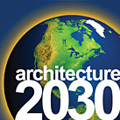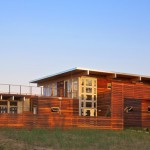Zero in on 2030 Now
 |
With buildings being the largest energy consumption group in the U.S., key leaders of the building design industry have established a goal of “zero net energy” buildings by the year 2030. The 2030 Challenge resolution calls for an immediate 40% reduction in fossil fuel energy consumption in new and renovated buildings, and it seeks to eliminate fossil fuels from new construction. In other words, within 25 years, cities that manage to meet the 2030 Challenge will not use oil, natural gas, or coal in the heating, cooling, lighting, or construction of new buildings. |
Right now we have a real opportunity to transform our economy from one running on fossil fuels to one largely based on clean energy. In the next twenty years the anticipated increase of energy consumption in the U.S. is projected to increase by more than 30%, while greenhouse gas emissions are also projected to increase by more than 30%. The 2030 Challenge seeks to help reverse this trend by setting a goal of carbon neutrality by the year 2030.
Goals of the 2030 Initiative
First, all newly constructed City buildings should be designed to consume a maximum of one half of the average fossil fuel usage for the building category as defined by the U.S. Department of Energy.
Second, the amount of existing building area equal to that of new construction is to be renovated annually to meet a fossil fuel, greenhouse gas (GHG) emitting, and energy consumption performance standard of 60% of the regional (or country) average for that building type.
Finally, all other municipal construction should employ green building practices to the greatest extent achievable.
The fossil fuel reduction standard for all new buildings will be increased to:
- • 60% in 2010
- • 70% in 2015
- • 80% in 2020
- • 90% in 2025
Building with PorterSIPs can help achieve the 2030 standard 20 years early:
The numbers above include reduction in fossil fuels related to heating and cooling, lighting, and construction of the building. SIPs are the enabling technology to reach the heating and cooling reduction. In fact, SIPs construction can meet the 2030 standard today. Generally speaking, the building envelope component of the 2030 goal is a 70% increase in energy efficiency when compared to the 2006 IECC. That equates to “30” HERS index and a “30” on the DOE E-Scale in the Builders Challenge Program. PorterSIPs has existing buildings that currently meet this requirement.
View the PowerPoint presentation to learn all about 2030 now.

